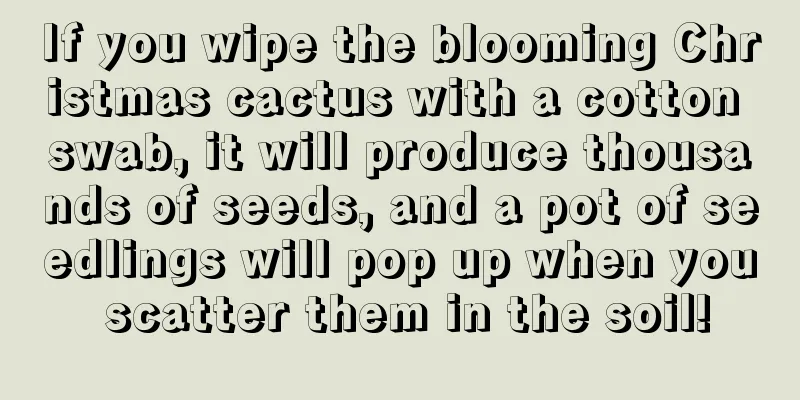If you wipe the blooming Christmas cactus with a cotton swab, it will produce thousands of seeds, and a pot of seedlings will pop up when you scatter them in the soil!

Pollination of Christmas cactus can be done with a cotton swab1. Pollination prerequisites Before pollinating Christmas cactus, observe whether its petals are fully open and whether the pistils and stamens are fully developed. As shown in the picture below, the mature Christmas cactus has mucus on its pistil and thick pollen on its stamens, so it can be pollinated at this time. 2. Pollination time In order to achieve successful pollination, you must choose the right time, preferably around 10 am on the second day after the flower blooms, because the light and temperature are suitable at this time, and the success rate of pollination is high. 3. Pollination method Find a clean cotton swab and rub the pollen from the small yellow stamens (stamens) below onto the red pistil head in the middle. As shown in the picture below, it has been rubbed with pollen, and there is light-colored pollen attached to the pistil in the middle. 4. After pollination After pollination, be careful not to let the Christmas cactus flowers get wet. Wait for the flowers to fall naturally and a small bulb will appear underneath. Allow the bulb to grow naturally and turn red, then you can pick it off and take out the seeds. 5. Is cross-pollination possible? Two different flowers on the same Christmas cactus can also be pollinated, and the seeds produced are still the original variety. Different Christmas cactus varieties can also be pollinated, and the varieties of seeds produced cannot be predicted, and new varieties may also appear. 6. What is the effect of sowing seeds? Christmas cactus can be propagated by sowing, and the sowing rate of self-harvested seeds is also very high. The seedlings that grow are also normal, except for extremely rare varieties. Because of its own hybrid instability, "atavism" will occur if it is propagated by seeds. Having said so much, let’s give it a try. The seeds of Christmas cactus are like dragon fruit, with so many small sesame seeds. They will sprout in ten days if they are scattered in the soil! Christmas cactus sowingThe germination rate of Christmas cactus is very high, and it is best to sow at a temperature above 15 degrees. If you have heating at home, don’t worry. If you don’t have heating, just wait until spring to sow. 1. Collect seeds You must wait until the seeds are completely red before picking them. You can't eat hot tofu in a hurry. Picking them before they are ripe will be a waste of time. Peel open the red seeds to reveal black sesame seeds. Place them on toilet paper to dry. 2. Prepare the soil It is best to use sandy soil or coconut bran soil for sowing. Before use, put it in the sun to dry it and spray some carbendazim water to disinfect it. This step can increase the germination rate and prevent bud rot. 3. Planting seeds Put the dried soil in a pot, spray it with a small spray bottle, and then sprinkle the seeds evenly on the surface. There is no need to cover them with soil or bury them, just sprinkle them directly. Place it in a shaded location indoors and spray water to humidify it regularly. , 4. Cover with plastic wrap If the temperature at home is not high enough or is relatively dry, you can cover it with a layer of plastic wrap and poke a few small holes in the plastic wrap for ventilation. 5. Nutritional supplement After the small sprouts emerge, they can be exposed to the sun for one hour every day. When they grow to 2-3 cm in height, you can put some slow-release fertilizer granules in them. This can prevent the seedlings from growing too tall or dying prematurely. 6. Prepare for transplanting When the seedlings grow to 5-8 cm in height, the original pot where they were planted is too densely, so prepare to dig them out and transplant them into new pots. It is best to add some slow-release fertilizer to the bottom of the pot as base fertilizer. It is basically mature and stable half a year after sowing. 7. Post-maintenance After successful transplanting, you can maintain it normally. Christmas cactus cannot be exposed to direct sunlight. 2-3 hours a day is enough. Don't water it too often. Wait until the soil on the pot becomes dry and white before watering. 8. Grafting The maintenance of native Christmas cactus is more difficult than that of grafted ones, because black rot is easy to occur if watering is not well controlled. Interested flower lovers can sow seeds first, and then pick them and graft them after the Christmas cactus grows standard leaves. |
>>: How to grow canna in spring
Recommend
When is the best time to prune bougainvillea?
Bougainvillea Overview Bougainvillea can bloom co...
Management of water and fertilizer for cactus
How to control fertilization of cactus During the...
How to cultivate air plants
Air Plant Growth Conditions Air plants are native...
Can I grow a Bodhi tree at home?
Can I grow a Bodhi tree at home? You can plant a ...
How to plant Kalanchoe? Planting time and method
Kalanchoe planting time Kalanchoe is a plant of t...
How often should I water my green radish? What should I pay attention to when watering?
How often should I water my green radish? During ...
The Flower Language and Legend of Amaryllis
Introduction to Amaryllis Name: Amaryllis Other n...
How to grow mousse water grass well
Mousse water grass growth conditions The suitable...
Gooseberry care methods and pest control
How to care for gooseberries Soil selection for g...
When and how to plant amaranth
Amaranth planting time You need to choose the rig...
What to do if the leaves of wolfberry bonsai turn yellow and fall off
main reason: Moist soil: Too wet soil is caused b...
Chrysanthemum brain planting time and method
Chrysanthemum brain planting time Chrysanthemum i...
How often should I water the red luck?
How often should I water the red luck? Red Fortun...
What flowers are good to grow in spring
1. Fortune Tree It is a perennially green shrub t...
What to do if asparagus fern leaves turn yellow
1. Increase the temperature Reason: If the temper...









